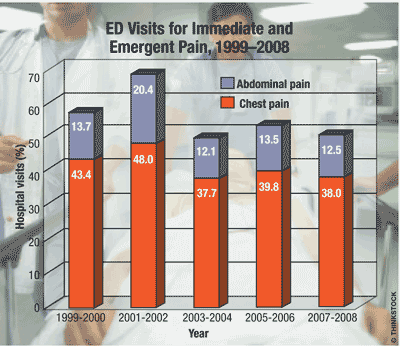US Pharm. 2011;36(5):10.
Pain of varying magnitude affects more people than diabetes, heart disease, and cancer combined. Because it is a leading cause of disability, pain adds significantly to the cost of health care. The National Center for Health Statistics (NCHS) estimates that one in four (76 million) Americans experiences pain that lasts for more than 24 hours. Chronic pain affects 50 million Americans and is a major contributor to long-term disability.

Hospital Emergency Department (ED) Visits: According to NCHS data, 62 million noninjury ED visits were made in 2008, constituting 22% more visits than in 2000. Chest pain and abdominal pain were the two most common reasons for ED visits. There was a 32% increase (from 5.3 million to 7.0 million) in the number of noninjury abdominal pain–related visits; however, chest pain as the primary reason for visits evidenced a nominal increase of 10% (5.5 million visits). Between 2000 and 2008, the percentage of noninjury ED visits due to chest pain declined, while the reverse was true for abdominal pain.
Severity: In 2008, the number of abdominal pain–related ED visits by patients arriving by ambulance was 27% higher than the number of such visits in 2000. Patients with chest pain who arrived by ambulance outnumbered patients with abdominal pain and patients with other symptoms. The number of chest pain patients seen by an ED triage nurse within 14 minutes of arrival (a criterion used to label an immediate or emergent case) decreased 13% between 2000 and 2008. A 7% decrease in triage was also evidenced for ED visits for symptoms other than chest or abdominal pain. However, the percentage of immediate or emergent chest pain visits was threefold higher than that for abdominal pain or other symptoms, according to the CDC.
Diagnosis: In noninjury ED visits, the use of advanced medical imaging for diagnosis increased significantly between 2000 and 2008 for chest pain (from 3.4% to 16%), abdominal pain (from 20% to 44%), and all other pain-related visits (from 8.6% to 19%). The number of ED visits for chest pain that was diagnosed as acute coronary syndrome decreased by 46% (from 24% to 13%) between 2000 and 2008. According to the CDC, there was no significant change for abdominal pain as a serious diagnosis.
Outcome: Hospital admission, transfer to other facilities, and death were overwhelmingly evidenced among noninjury chest pain–related ED visits. Between 2000 and 2008, however, this rate declined by 17%, unlike abdominal pain–related ED visits, which remained constant.
To comment on this article, contact rdavidson@uspharmacist.com.





